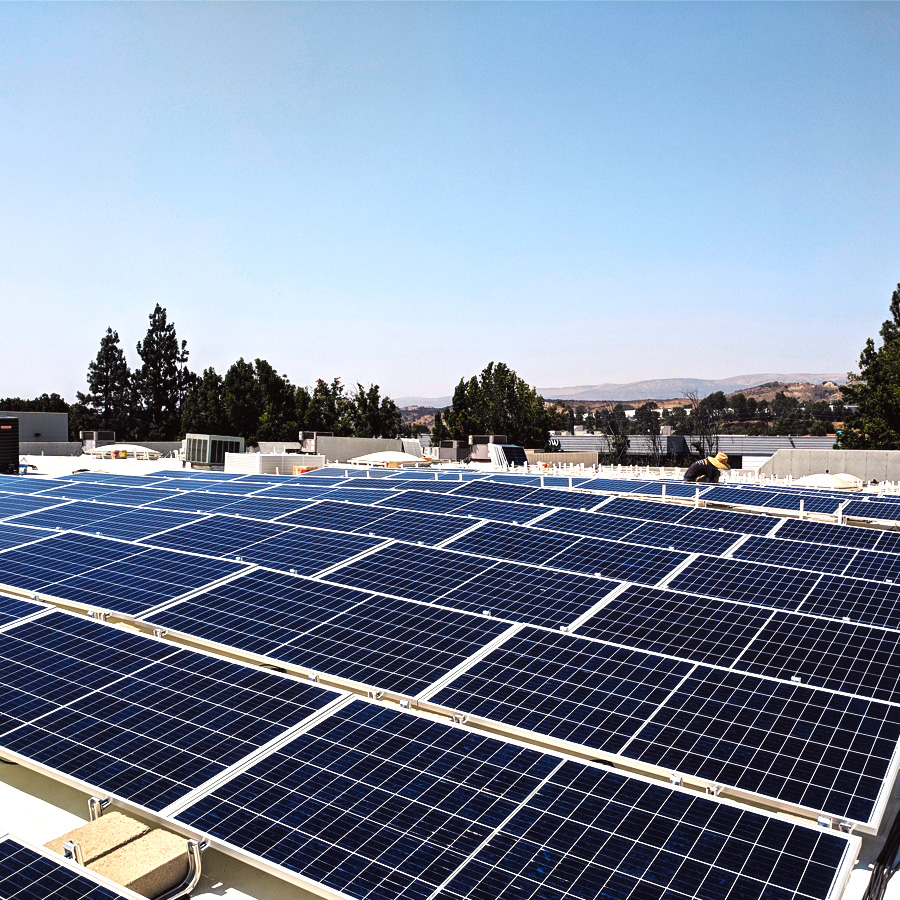Solar Incentives, Tax Credits and Rebates in California
California residents have access to a variety of solar rebates, tax credits, and incentives. These include federal tax credits as well as rebates offered by local utility companies. Keep in mind that eligibility for these incentives may depend on factors such as your location, utility provider, income, and interest in battery storage. Note – this is not tax advice and you should always consult a tax pro to see how this applies to you.
Federal tax credits
The Federal Solar Tax Credit, also referred to as the Residential Clean Energy Credit, is available to most California residents. It allows for a deduction of up to 30% of the cost of installing a solar panel system from your federal taxes. This means that if your solar installation costs $20,000, you could potentially receive a tax credit of $6,000 to be used to reduce your federal income tax for the tax year in which the system was installed. Essentially, it acts as a 30% discount on the cost of your home solar installation provided by the federal government.
Low income support
The Disadvantaged Communities Single-Family Affordable Solar Homes (DAC-SASH) Program was established by California to promote the use of renewable energy in disadvantaged communities. The program provides qualified homeowners with fixed, upfront, capacity-based incentives that can help reduce the cost of a solar energy system. Eligible homeowners can receive up to $3 per watt through the program, as per the California Public Utilities Commission. To qualify for the program, homeowners must meet the following criteria:
- Live in and own the home
- Receive electrical service from Pacific Gas & Electric (PG&E), Southern California Edison (SCE), or San Diego Gas & Electric (SDG&E)
- Enroll or be eligible for CARE or FERA income-qualified utility bill programs
- Live in a disadvantaged community (DAC) qualified area
If you believe you meet the eligibility requirements, visit the GRID Alternatives website for more information.
Property tax exclusion
In California, individuals who install a solar or wind-powered system to generate energy for their home or business are eligible for an exemption on property taxes for the added value the system brings to the property. This means that until 2025, property owners who install solar panels or other solar-powered devices on their property will not have to pay property taxes on the increased value of the property resulting from the installation of the system. This is a great benefit, particularly for those who require a larger system to offset their electricity consumption. It is a double benefit where not only you save on electricity bills but also on property taxes.
Net metering program
Homeowners who install solar panels on their property can participate in California’s net metering program. Net energy metering (NEM) is a system where utility companies offer credits to homeowners for the extra electricity generated by their solar panels and added to the electricity grid. Under net metering, homeowners are only billed for their net usage, which is the difference between the total energy produced by their solar system and the total energy consumed by their home. The program is offered by the three major investor-owned utility companies in California: Pacific Gas & Electric (PG&E), Southern California Edison (SCE), and San Diego Gas & Electric (SDG&E), and is regulated by the California Public Utility Commission.
To participate in the program, there are a few requirements to be aware of:
- A one-time interconnection fee between $75-$145 depending on the utility company
- Payment of non-bypassable charges that fund low-income, energy efficiency, and other similar programs
- Switching to time-of-use (TOU) energy rates At the end of a 12-month billing period, customers may receive compensation for any surplus credits on their account at the “fair market value” through net surplus compensation (NSC) which changes based on the 12-month rolling average of the market rate for electricity and can be found on your utility company’s website.
Similarly, municipalities and other electric cooperatives such as Los Angeles Department of Water and Power (LADWP) also provide net metering credits to residential solar owners in their territories, but the value of the credit is determined by the policies set by the municipal utility company or electric cooperative’s governing board.
In summary, California residents have access to a variety of solar incentives, including federal tax credits, local utility rebates, and programs to offset the cost of solar energy systems for qualified homeowners. Want to learn more? Call 1-844-SUN-EASY to learn what installing solar could do for you!
The 5 Key Advantages of Solar Energy for Businesses
As more and more businesses look for ways to reduce costs and become more sustainable, solar energy is becoming an increasingly popular option. Solar energy offers a wide range of advantages for businesses, including cost savings, environmental benefits, and increased energy independence. Here are five key advantages of solar energy for businesses:
Cost savings
One of the biggest advantages of solar energy for businesses is the cost savings. Solar energy can help businesses save money on their energy bills by reducing or even eliminating their reliance on traditional energy sources. According to the National Renewable Energy Laboratory (NREL), a typical commercial solar panel system can offset between 50-70% of a business’s electricity consumption. This can lead to significant cost savings over time.
Increased energy independence
Solar energy also provides businesses with increased energy independence. By generating their own power, businesses can reduce their dependence on the traditional energy grid and be less affected by power outages and fluctuations in energy prices.
Environmental benefits
Another advantage of solar energy for businesses is the environmental benefits. Solar energy is a clean and renewable energy source, which means it does not produce any emissions or pollutants. By installing solar panels on their properties, businesses can decrease their carbon footprint and contribute to a more sustainable future.
Increase in property value
Installing solar panels on your property can increase the property value, according to a study by the Lawrence Berkeley National Laboratory, solar systems can increase the value of a property by about 4.1% on average. This is because buyers are willing to pay more for a property that generates its own power.
Tax Incentives and subsidies
Many governments offer tax incentives and subsidies to businesses that install solar panels on their properties. This can help to offset the initial cost of installation and make solar energy a more affordable option for businesses.
In summary, solar energy offers a wide range of advantages for businesses, including cost savings, increased energy independence, environmental benefits, increase in property value, and tax incentives and subsidies. As the cost of solar technology continues to decline and more businesses adopt solar energy, it’s becoming a more viable option for businesses of all sizes. Want to learn more? Call 1-844-SUN-EASY to learn what installing solar could do for you!
The Impact of Residential Solar Energy on the Environment
The use of solar energy is on the rise as more and more homeowners are turning to this renewable energy source to power their homes. The installation of solar panels on your home not only reduces your energy costs but also has a significant impact on the environment.
Reducing greenhouse gas emissions
One of the most significant impacts of solar energy on the environment is the reduction of greenhouse gas emissions. Fossil fuels, such as coal and natural gas, are the main sources of energy for electricity generation. However, burning these fuels releases carbon dioxide and other harmful pollutants into the atmosphere, contributing to climate change. By installing solar panels on your home, you are directly reducing your reliance on fossil fuels, which in turn reduces the amount of greenhouse gas emissions. This, in turn, helps slow down the effects of climate change and preserve our planet for future generations.
Decreasing demand for fossil fuels
A typical residential solar panel system can offset the equivalent of three to four tons of carbon dioxide emissions per year, decreasing the demand for fossil fuels, which are the main sources of energy for electricity generation. According to the National Renewable Energy Laboratory (NREL), a typical residential solar panel system can offset the equivalent of three to four tons of carbon dioxide emissions per year. That’s the same as planting over 100 trees annually or taking one car off the road.
Preserving natural resources
Another benefit of solar energy is that it helps to preserve natural resources. Solar energy is generated through the use of photovoltaic cells, which convert sunlight into electricity. Unlike fossil fuels, which are finite resources, the sun’s energy is abundant and will be available for generations to come. By harnessing this renewable energy source, we can reduce our dependence on finite resources, such as coal and natural gas, and preserve them for future generations.
In summary, the installation of solar panels on your home not only reduces your energy costs but also has a significant impact on the environment. By reducing greenhouse gas emissions and preserving natural resources, solar energy helps to preserve our planet for future generations. Want to learn more? Call 1-844-SUN-EASY to learn what installing solar could do for you!
Going Solar: A Step-by-Step Guide for Homeowners
Going solar is a great way for homeowners to save money on their energy bills and reduce their carbon footprint. By installing solar panels on your property, you can generate your own electricity and potentially even sell excess power back to the grid. The process of going solar may seem daunting, but it’s actually quite simple and straightforward. Here is a step-by-step guide for homeowners looking to go solar:
Conduct a site assessment
The first step in going solar is to have a professional conduct a site assessment. This assessment will determine the size and type of solar system that is best for your home and energy needs. It will also take into consideration factors such as the direction and angle of your roof, shading, and local weather patterns.
Research and Compare solar providers
After getting your site assessment done, research and compare different solar providers and their pricing, warranties and services.
Get quotes and choose a provider
Get quotes from multiple providers, compare them and choose the one that best suits your needs. Make sure to check the company’s reputation, customer reviews and certifications.
Sign a contract and secure financing
Once you have chosen a provider, sign a contract and secure financing if needed. Some providers offer financing options, while others may require you to pay upfront.
Design and Installation
The design and installation phase is where the actual solar panels are installed on your property. This process typically takes a few days and is typically handled by a team of trained professionals.
Connect to the grid
Once the installation is complete, your solar energy system will be connected to the grid and you can start generating your own electricity.
Monitoring and maintenance
After the installation, monitor your system regularly and schedule regular maintenance check-ups to ensure optimal performance and longevity of the system.
Going solar is a great way to reduce your energy costs and your carbon footprint. With a little research and planning, the process of going solar can be easy and straightforward. By following these simple steps, you can be on your way to generating your own clean energy in no time. Want to learn more? Call 1-844-SUN-EASY to learn what installing solar could do for you!
California Leads the Way in Solar Panel Installations
California is known for its sunny weather and progressive environmental policies, and it’s no surprise that the state is leading the way in solar panel installations. The Golden State has been at the forefront of the solar energy movement for decades, and it continues to set the standard for other states to follow. Here’s a closer look at how California is leading the way in solar panel installations and what other states can learn from its example.
Renewable energy goals
One of the key reasons why California is leading the way in solar panel installations is its aggressive renewable energy goals. The state has set a target of generating 100% of its electricity from renewable sources by 2045, and solar energy is a big part of that equation. To meet this goal, the state has implemented policies and incentives to encourage the installation of solar panels on homes and businesses. This has helped to increase the amount of solar energy generated in the state and make it more accessible to residents and businesses.
Plenty of sunshine
Another reason why California is leading the way in solar panel installations is its abundance of sunshine. The state receives more sunlight than most other states in the country, which means that solar panels can generate more energy. This, in combination with the state’s policies and incentives, has made it easier and more cost-effective for residents and businesses to install solar panels and generate their own power.
Largest solar industry
California’s solar industry is also well-established and growing rapidly. According to the Solar Energy Industries Association (SEIA), California is home to more solar jobs than any other state in the country. The state’s solar industry currently employs over 100,000 people and is projected to continue growing in the coming years.
Environmental impact
Finally, California’s solar panel installations have a huge impact on the environment. According to the California Energy Commission, the state’s solar installations have avoided the emission of over 13 million metric tons of greenhouse gases since 2006, which is equivalent to taking 2.8 million cars off the road for a year.
In conclusion, California is leading the way in solar panel installations because of its aggressive renewable energy goals, abundance of sunshine, well-established solar industry and positive environmental impact. Other states can learn from California’s example by implementing policies and incentives to encourage the installation of solar panels, as well as supporting the growth of the solar industry. Want to learn more? Call 1-844-SUN-EASY to learn what installing solar could do for you!




